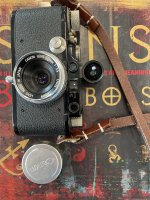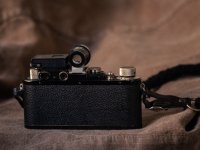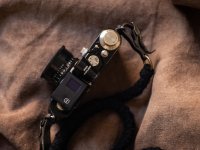Was not sure what thread to post this in. It's a question regarding either early Barnacks, Leica Barnack cases, or how to load a Barnack.
The following are photos of an ESNAR case which came with a1932 Leica II, both of which were well preserved. Regarding the card which is found in the case: I have looked extensively, and what little information I have been able to find related to what it is, exactly, seems either inconclusive or obviously incorrect. The most widely posited view, and even that all not that widely, is that this was a card to be used for taking notes on, which notes could be removed and the card then ready for the next roll. The reason that seems obviously incorrect to me is that it is firm and slick and it is impossible to write on it with a pencil, or a fountain pen, or a ballpoint pen. You can write on it, for that purpose, with a dry erase marker, but those did not exist in 1932. You could write on it with a grease pencil, but anyone who has ever written with a grease pencil knows that you would not be able to get much on there in the way of a note.
The other suggestions I have seen mentioned boiled down to "I don't know, must be something." Indeed.
I am not suggesting the following, but do note that the stiffness, thickness, and shape do lend themselves, exactly to sliding behind the shutter to protect it from film attached to both spools and being dropped in behind the shutter. To which I can attest, drops in quite instantly. Yet, this practice is something which some in today's times either forbid or promote. I can't find any mention of using this card in early manuals I have, though I do not have a manual which dates as far back as this ESNAR case.
Anyone know what this card is conclusively for? Seems semi-obviously to me that it is for loading film, but conventional wisdom is that that's a no no. (Not everyone's conventional wisdom.) And I would note that there is definitely no reason to set it to Bulb, etc to see where it goes, if you are using it to load film, because it slots right in and it is so stiff, that there is only one place it can go.
. . .

















